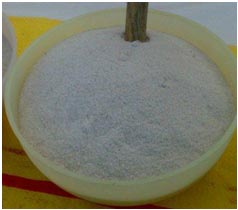 |
|
|
Translate this page in your preferred language:
|
|
FEEDING OF DAIRY ANIMALS : |
| Back |
Feed:
What Is Feed ?
The important feed ingredients are carbohydrates, proteins, fats, minerals, vitamins and water. These ingredients are supplied through roughages and concentrates. Before embarking on a dairy farming enterprise it is important to find out the type of feeds available affordably in your area.
Types of feeds can be divided into:
- Forages (Roughages): these include Napier grass, hay, grass, maize (Stover and residues) plants, and banana pseudo stems. Fodder legumes like leucaene (Leucaena leucocephala), calliandra (Calliandra calothyrsus), sesbania (Sesbania sesban) and gliricidia (Gliricidia sepium).
- Concentrates: these include wheat bran, maize germ, dairy meal, and pollard or maize bran. These types of feeds cannot be produced on small or medium scale farms, as they require large capital investments. Concentrates are usually used in small quantities, unlike forages.
- Other byproducts: e.g. cotton seed cake, fishmeal, molasses, brewer’s waste and poultry waste. These are usually by products of other industrial or farm enterprises, but are rich in nutrients that increase productivity of dairy animals.
- Feed additives: e.g. minerals and vitamins, livestock salts, buffers, enzymes, probiotics yeast and urea. These also have to be purchased and are an essential component of costs in a dairy enterprise.
Guideline for preparation of 100kg feed:
- Crushed maize: 42kg
- Oats/wheat/rice bran: 35kg
- Oil cakes: 20kg
- Mineral mixture: 2kg
- Salt: 1kg
Balanced Ration:
- During formulation of dairy cow rations, the daily requirements for all the above nutrients must be taken into consideration.
- The available feed resources should then be mixed to meet the cow's nutrient requirements, which are dependent on bodyweight, milk yield, reproductive (pregnancy) requirements and growth.
- A balanced ration will consist of combined feed ingredients which will be consumed in amounts needed to supply the daily nutrient requirements of the cow, both in correct proportion and amount.
- A ration will be balanced when all the required nutrients are present in feed eaten by the cow during a 24 hour period.
- When a ration is not balanced, the cow eats some nutrients in excess or in insufficient amounts.
- Some excesses and deficiencies, if not checked, can lead to death (e.g. calcium deficiency resulting in milk fever).
- A properly balanced ration will therefore be a mixture of all the ingredients.
Practical feeding:
During the formulation of rations for lactating dairy cows, the quality of the ration should be commensurate with the requirements of the cow.
The requirement is directly related to the milk yield, which is in turn dependent on the stage of lactation. Cows in the same stage of lactation will have almost similar requirements and can therefore the rations can be formulated according to the phase (stage) of lactation.
Phase 1: (1-70 days)
- During this phase, milk production increases more rapidly than feed intake resulting in higher energy demand than intake leading to a negative energy balance.
- The health and nutrition of the cow during this phase is critical and affects the entire lactation performance.
- Excessive weight loss may be detrimental to cow's health and reproductive performance (cow may not come on heat at the optimum time) leading to long calving intervals.
- Concentrates should be added to the basal diet to increase the energy and protein content as forage alone will not be sufficient.
- Cows that are poorly fed during this early phase do not attain peak yield and milk production drops from 1st week.
- If excessive concentrates are added too rapidly (non-accustomed cows) to the ration, they can lead to digestive disturbances (rumen acidosis, loss of appetite, reduced milk production, low milk fat content). It is therefore recommended that concentrates should be limited to 50-60% of diet dry matter, the rest being forage to ensure rumination (proper function of the rumen).
- If high amounts of concentrate are fed during this time buffers (chemicals that reduce the acid in the rumen and available commercially) can be helpful.
- At this stage, high protein content is important since the body cannot mobilize all the needed protein and bacteria protein (synthesized in the rumen by bacteria) can only partially meet requirements.
- A ration with protein content of 18%CP is recommended for high yielding cows. If the cow is underfed during this stage, milk production cannot recover even when balanced rations are fed at later stages.
Phase 2: (70-150days)
- During this phase the dry matter intake is adequate to support milk production and either maintain or slightly increase body weight.
- Feeding should be to maintain production peak as long as possible.
- Decline of 8-10%/month in milk production are common after peaking.
- The forage quality should still be high and a CP content of 15-18%.
- Concentrates high in digestible fiber (rather than starch) e.g. wheat or maize bran can be used as energy source.
Phase 3: (151-305days)
- During this phase feed intake and milk production decline.
- The body weight increase is due to replenishment of body reserves and, towards the end of lactation, due to increased growth of fetus.
- It has been shown that it is more efficient to replenish body weight during late lactation than during the dry period.
- The animals can be fed on lower quality roughage and limited amounts of concentrate compared to the other two phases.
Phase 4: (Dry Period: 305-365days)
- During this phase the cow continues to gain weight primarily due to weight of fetus.
- Proper feeding of cow during this stage will help realize the cow's potential during next lactation and minimize health problems at calving time (milk fever and ketosis).
- At the time of drying, cows should be fed a ration to cater for maintenance and pregnancy but two weeks before calving, the cow should be fed on concentrates in preparation for next lactation.
- This extra concentrate (steaming) enables the cow to store some reserves to be used in early lactation and to adapt rumen microbial population to digest concentrates in early lactation to minimize digestive disturbances.
- During this phase the cow can be fed good quality forage or poor quality supplemented with concentrate to provide 12% CP.
- The cows should not be fed high amounts of concentrate to avoid over conditioning. If the diet is rich in energy, intake should be limited.
- Bulky roughages can be fed to help increase rumen size to accommodate more feed at parturition.
- The amount of calcium and phosphorous fed should be restricted during the dry period to 0.4% and 0.25% to minimize incidences of milk fever.
Guidelines for concentrate feeding:
- It should be noted that feedstuffs available in the market e.g. bran (wheat or maize), pollard or maize germ are not similar to the mixed concentrate as they are low in protein and minerals and should be used in combination with other ingredients when supplementing forages.
- The maximum amount of milk that can be produced without concentrate supplementation will depend on the quality of the pasture or forage. This has been reported to vary from 7-20 kg milk per day.
- Several guidelines have been suggested on the amount of concentrate that should be fed to a cow. The only accurate one is the one calculated based on the cow’s nutrient requirements and the quality of the basal diet by a nutritionist.
- The example below is one of the many guidelines:
Up to 7 kg of milk comes from the basal forage diet.
For every extra 1.5kg milk above 7kg, give 1kg dairy meal.
Feeding of dairy buffalo:
Feeding:
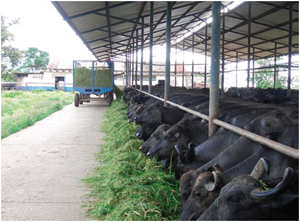 |
|
Forages being fed to buffaloes in large farm by help of distribution trolley
|
Requirements for buffalo are more or less the same as for cattle, so nutrient requirement tables for dairy cattle may be used as a guide. A farmer must observe the animals and change the feeding system, with guidance from an extension officer, if the feed seems unsuitable.
Energy:
- Sources of energy are predominantly carbohydrates like fibre and starch, and fat to a lesser extent.
- For buffalo, fibre in the form of roughage is the most important and cheapest energy source.
- The energy ratio in the feed may be increased by adding fat in protected form, thus transferring its digestion from the rumen to the intestinal tract.
- Feeding of protected fat has been proven to increase nutrient utilization.
Protein:
- Protein is required for growth, tissue repair and milk production.
- Good sources of protein are leguminous forage, grain and oilseed cakes.
Minerals and vitamins:
- The macro-minerals calcium (Ca) and phosphorus (P) are especially important in milk production.
- They are also vital for the skeleton and the function of nerve impulses.
- Phosphorus is the mineral included in the body’s energy metabolism, ATP.
- When considering Ca and P requirements for the animal it is equally important to consider the ratio in which they are given.
The Ca:P ratio should be 2:1 since there is an antagonist relationship between the two minerals concerning uptake from the small intestine.
- Vitamins are essential for total body function. Most vitamins are synthesized by the animal or its rumen microbes.
Such vitamins, B, C and K (and to some extent D) do not need to be fed.
- Vitamins A and E are not synthesized in the animal but must be supplied. Vitamin A is found in silage, fresh grass, dark green leaves, peas and carrots. Cereals are a source of vitamin E. Mineral and/or vitamin mixture should always be supplied in order to fully meet the requirements.
Water:
- Water is essential for most body functions, such as body temperature control, milk production and maintaining blood plasma volume.
- Thermal regulation of the animal is the most water consuming process. The animal receives water in three different ways:
- drinking water
- water in feed
- Metabolic water = water made from feed degradation.
Drinking water is the most important water source and should be of good hygienic quality. The water available in feed is highly dependent on the dry matter in feed. Straw, hay and cereals include little water, whereas silage and fresh grass may contain as much as 70% or more.
Generally, buffalo require more water than cattle under the same circumstances and should have access to clean cool water ad-libitum. Restricted water intake leads to a decrease in dry matter intake and thus negatively affects milk production and growth.
 |
|
 |
|
Watering buffaloes in watering alley |
|
Roughages being fed to the buffaloes
|
Practical feeding of the lactating buffalo:
- Lactating buffalo should be given the best feed the farm can offer. Producing milk is one of the most energy demanding biological processes.
- Weight loss is common in high producing animals during the first month of lactation because they cannot consume a sufficient amount of energy.
- In Table c, examples of various feeding regimes for lactating buffalo are given.
- Traditional feeding patterns for buffalo all over the world are subject to seasonal forage and crop production, which affects the level of milk production.
- Forage is insufficient during the dry season and abundant during the rainy season.
Shortages are overcome by conserving forages as hay or silage.
Formulating balanced feed rations for lactating buffalo:
- Formulating feed rations for milk producing buffalo starts with theoretical calculating of the requirements.
- As there are no standardized international tables for dairy buffalo requirements, the calculations in Table a, are based on dairy cattle nutrient requirement tables (NRC, 1988).
- It is important to know the buffalo live weight. This is most accurately done by weighing the animals three times in one week and calculating the average.
- Once the weight is known, requirements for maintenance can be extracted. Milk yield should also be known, as well as fat percentage.
- Recommendations are to use at least three days of milk records to calculate the average yield and fat percentage. For simplicity, the yield is then calculated as four percent fat corrected milk. Total requirements are gained by summing the requirements for maintenance and for milk production.
- The requirement for milk production is based upon the calculation of fat corrected milk (FCM) using the formula:
4% FCM, kg = 0.4 x (milk yield, kg) + 15 x (milk yield, kg x fat%/100)
Table a: Nutrient requirements of buffalo:
| Requirements for live weight (kg) |
Energy (ME in Mcal) |
TDN (kg) |
Total crude protein (g) |
Calcium (g) |
Phosphorous (g) |
| 450 |
13 |
3.4 |
341 |
18 |
13 |
| 500 |
14.2 |
3.7 |
364 |
20 |
14 |
| 550 |
15.3 |
4.0 |
386 |
22 |
16 |
| 600 |
16.3 |
4.2 |
406 |
24 |
17 |
| Requirements for milk yield per kg 4% fat corrected milk: |
|
1.24 |
0.32 |
90 |
2.73 |
1.68 |
For a buffalo weighing 550 kg and yielding 7 kg of milk with 7.2% fat per day, the amount of
4% fat corrected milk comes to 0.4 x 7+15 x (7 x 0.072) = 10.36 kg per day.
- If the animal seems to be too fat at the time of weighing, the maintenance requirements may be reduced by ten percent. Similarly, if the animal is too skinny, ten percent may be added to the maintenance requirements.
The feeding regime of the buffalo can then be decided.
- Primarily, crops grown on the farm should be included in the diet.
- It is important to note that silage should not form the sole source of roughage because it has a high amount of easily fermentable carbohydrate and a physical structure which does not really stimulate rumen contraction. As a rule of thumb, the amount of silage in a diet should not exceed 30% of the total dry matter intake if concentrate is also given.
- Including urea in the diet may be a cheap and good way to “help up” a low protein diet. An alternative is to feed readymade urea-molasses blocks.
Table b: Examples of nutrient content of common feedstuffs used for feeding dairy animals:
| Feed name (live weight kg) |
Energy (ME in Mcal) |
TDN (kg) |
Total crude protein (g) |
Calcium (g) |
Phosphorous (g) |
| Alfalfa hay |
2.36 |
0.63 |
200 |
15.4 |
2.2 |
| Napier grass |
2.0 |
0.55 |
87 |
6 |
4.1 |
| Rape fresh |
3.16 |
0.81 |
164 |
- |
- |
| Oats |
2.73 |
0.6 |
140 |
- |
- |
| Sorghum fresh |
2.36 |
0.63 |
88 |
4.3 |
3.6 |
| Sorghum silage |
2.14 |
0.58 |
62 |
3.4 |
1.7 |
| Maize silage |
2.67 |
0.7 |
81 |
2.3 |
2.2 |
| Wheat straw |
1.51 |
0.44 |
0 |
1.8 |
1.2 |
| Rape seed |
2.93 |
0.76 |
390 |
7.2 |
11.4 |
| Cotton seed cake |
2.71 |
0.71 |
448 |
1.9 |
1.2 |
| Wheat bran |
2.67 |
0.7 |
171 |
11.8 |
3.2 |
| Molasses |
2.67 |
0.7 |
103 |
11 |
1.5 |
| Urea |
0 |
0 |
281 |
0 |
0 |
Table c: Examples of feeding regimes for a lactating dairy animal weighing 550 kg:
| Milk yield (7% fat) |
4% FCM |
Kg dry matter of roughage |
Kg dry matter of concentrate |
| 4kg |
5.8kg |
3.5 alfalfa hay + 3.2 maize silage + 4 wheat
straw or |
2 wheat bran |
| 5kg |
7.40kg |
2 alfalfa hay + 4 maize silage + 4 fresh sorghum |
- |
| 7 kg |
10.15 kg |
5.3 alfalfa hay + 5.5 maize silage or
4.5 alfalfa hay + 5 maize silage + 2 wheat straw or
3.5 alfalfa hay + 5.5 maize silage and |
2 wheat bran |
| 9 kg |
13.05 kg |
5.6 alfalfa hay + 5.5 maize silage + 3 wheat
straw or
4.5 alfalfa hay + 5.5 maize silage and |
2.5 wheat bran |
| 10 kg |
14.50 kg |
6 alfalfa hay + 7 maize silage or 9 alfalfa hay
+ 3 maize silage and |
1 cotton-seed-cake |
| 12 kg |
17.40 kg |
7 alfalfa hay + 5 maize silage + 2 wheat straw
and |
1.5 wheat bran |
| 15 kg |
21.75 kg |
7.5 alfalfa hay + 6 maize silage and |
2.2 wheat bran + 0.5 molasses + 0.3 urea |
Practical feeding of buffalo calf:
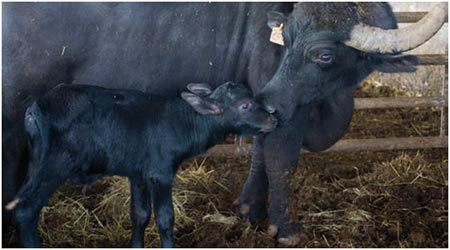 |
|
Buffalo calf with dam
|
Calf starter mixture:
| Feed source |
Amount |
| Crushed barley |
50% |
| Groundnut cake |
30% |
| Wheat bran |
8% |
| Skim milk powder |
10% |
| Mineral mixture |
2% |
| To increase palatability, add per 100kg of starter: |
| Molasses |
5-10kg |
| Salt |
500g |
- Buffalo calves fed with stovers of maize, bajra and oat cannot meet their nutrient requirements and are often in negative energy and protein balance. However,
feeding the calves treated stovers with a urea-molasses-salt complex both enhances the palatability of the stovers as well as the digestibility and nutrient value.
- Buffalo male calves weighing 150 to 200 kg have been proven to increase their intake of treated stovers compared to untreated ones, thus increasing weight gain and improving nitrogen balance and health.
Practical feeding of the heifer:
- The heifer is a future milk producer and has to be given a fair chance to produce well.
She must have an average daily gain of at least 500 grams per day in order to reach the optimum size for calving within a reasonable time (500 kg at 32 to 40 months).
- Heifers should be fed seasonal green feed of about 4 to 7 kg dry matter (DM) together with some straw and concentrate or grain per day.
- If the green feed is leguminous the ration of green feed and concentrate or grain can be reduced and the amount of straw increased. However it is important to feed the heifers a small amount of grain or concentrate, not less than 0.5 kg per day, to help both them and their rumen to become accustomed to this type of feed prior to partus.
- If available, ammonia treated straw could be given along with low quality green feed and concentrate.
- Silage could be given to heifers, but it is often a very valuable feed saved for milk producing animals. However, a few months before partus the heifer should slowly be introduced to the feed she will have as a milk-producing buffalo.
- Maximum voluntary intake for the heifer is obtained at approximately 1 to 1.5 kg DM of straw together with 3 kg DM of green feed and 1 kg concentrate.
- Straw fed to appetite is not enough to keep or increase the body weight of growing buffalo. Straw fed to growing stock should preferably be ammoniated and further supplemented with green feed or hay and some kind of concentrate to give the best result.
Practical feeding of the dry buffalo:
- Feeding the dry buffalo is concerned with preparing for partum and high milk production.
- In the last two months of gestation the buffalo has increased requirements for nutrients for foetal growth.
- Experiments with Murrah buffalo has shown that the best economical way of feeding dry buffalo two months before calving is at 125 percent of the recommended level for cattle (NRC, 1988).
- By giving the dry buffalo a little more than she needs, her chance of building up body reserves and being in good physical condition is improved.
COMMON FEED INGREDIENTS OF DAIRY ANIMALS :
Cereals:
1. Maize:
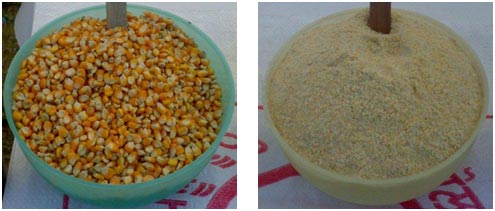 |
|
Grain form Ground form
|
| (Crude Protein-10%; Ether extract-2.5%)
|
2. Rice kani:(Crude Protein-10%; Ether extract-2.5%)
3. Rice polish:
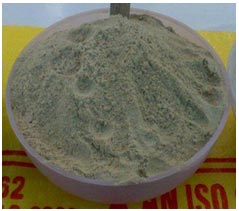 |
| Ground form
|
| (Crude Protein-12-14%; Ether Extract-14-16%) |
4. De-oiled Rice Polish:
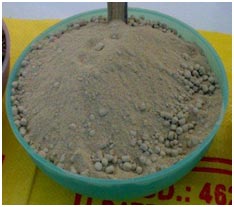 |
| Ground form
|
| (Crude Protein-14-18%; Ether Extract-0.5-1.0%) |
5. Brewers’s Dried Grains:
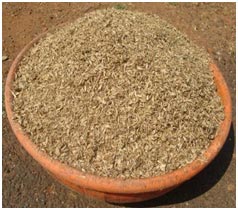 |
| (Crude Protein-25%; Ether Extract-5%) |
6. Soybean Meal:
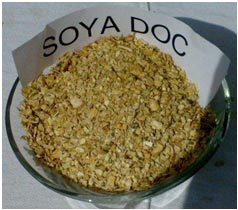 |
| (Crude Protein-48-50%; Ether Extract-0.5-1.0%) |
7. Groundnut Cake:
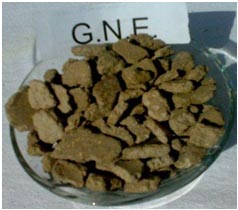 |
|
(Crude Protein-45%; Ether Extract-0.5-1.0%)
|
8. Mustard Seed Cake:
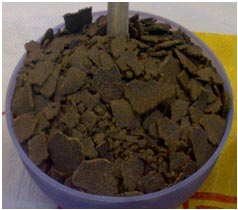 |
|
(Crude Protein-35%; Ether Extract-7%)
|
9. Cottonseed Cake: (Crude Protein-25%; Ether Extract-7%)
Mineral Mixture:
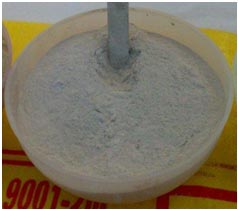 |
|
(Calcium-20%; Phosphorus-16%)
|
Common Salt:
Green Fodder:
1. Cowpea Green Fodder:
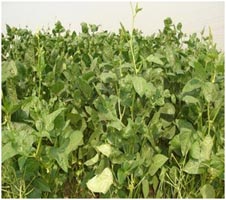 |
|
(Crude Protein-15-20%)
|
2. Maize Green Fodder:
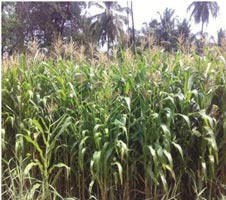 |
|
(Crude Protein-8-10%)
|
3. Napier Bajra Hybrid (CO-3) Green Fodder:
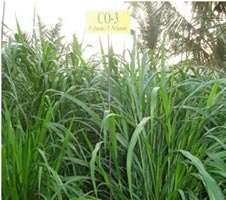 |
|
(Crude Protein-8-10%)
|
4. Napier Bajra Hybrid (CO-4) Green Fodder:
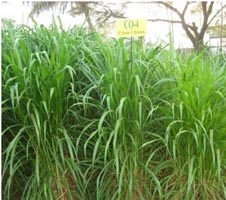 |
|
(Crude Protein-8-10%)
|
5. Green Karad Grass:
 |
|
(Crude Protein-2.5-3.0%)
|
Dry Fodder:
1. Paddy Straw:
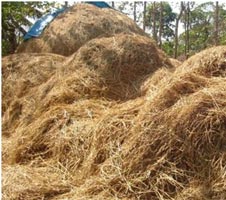 |
|
(Crude Protein-2.5-3.0%) |
2. Dry Karad Grass:
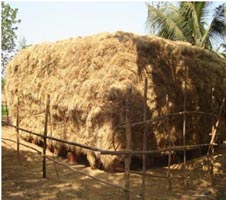 |
|
(Crude Protein-5-6%) |
3. Jowar Straw (Kadaba Kutti):
 |
| (Crude Protein-3.5-4.5%) |
Seasonal cultivation of green fodder in North India:
| July-October |
Napier
Sorghum
Bajra/Jowar
Cowpea
|
| November-April |
Napier + Lucerne
Berseem + Mustard
Lucerne + Oat
|
| May-June |
Napier + Lucerne
Sudan grass
Lucerne
Early Maize
|
BUREAU OF INDIAN STANDARD (BIS) SPECIFICATIONS FOR COMPOUNDED CATTLE FEED:
| Nutrients (%) |
Type-I |
Type-II |
Calf Starter |
Calf Grower |
| Moisture (Max) |
11 |
11 |
10 |
10 |
| Crude Protein (Min)
|
22 |
20 |
23-26 |
22-25 |
| Ether Extract (Min) |
3.0 |
2.5 |
4.0 |
4.0 |
| Crude Fiber (Max) |
07 |
12 |
07 |
10 |
| Acid Insoluble Ash (Max) |
3.0 |
4.0 |
2.5 |
3.5 |
| Salt as NaCl (Max) |
2.0 |
2.0 |
--- |
|
| Calcium (Min) |
0.5 |
0.5 |
--- |
|
| Available Phosphorus |
0.5 |
0.5 |
--- |
|
| Vit A (IU/kg) |
5000 |
5000 |
--- |
|
COMPOSITION OF CALF STARTER:
Calf starter is a balanced concentrate mixture, which is fed to the calves from 10th day of age to supplement the nutrients, when they are raised on limited milk intake.
Composition of calf starter:
| Ingredients |
Parts (kg/100 kg) |
| Maize/ wheat shorts/ barley/ oats |
50 |
| Groundnut cake/ soybean meal |
30 |
| Skimmed milk powder |
07 |
| Wheat bran/ rice bran |
10 |
| Mineral mixture |
02 |
| Common salt |
01 |
| Vitamin A and D supplement (g/q) |
10 |
| Available Phosphorus |
0.5 |
COMPOSITION OF CONCENTRATE MIXTURE:
It is a mixture of different concentrate feed ingredients like cereal grains (maize, rice kani etc), cereal grain byproducts (rice polish, brewers’ dried grains etc), oil cakes (soybean meal, ground nut cake, cotton seed cake etc), mineral mixture and common salt in different ratios as per the requirement.
Examples of Concentrate Mixture:
| Feed Ingredients |
Parts by Weight
(kg) |
| Ex-1 |
Ex-2 |
Ex-3 |
Ex-4 |
Ex-5 |
| Maize grain (ground) |
35 |
35 |
35 |
35 |
35 |
| Soybean meal |
15 |
20 |
--- |
10 |
10 |
| Groundnut cake |
15 |
--- |
24 |
--- |
15 |
| Cotton seed cake |
--- |
12 |
24 |
27 |
14 |
| Rice polish |
32 |
30 |
14 |
--- |
23 |
| Brewers’ dried grains |
--- |
--- |
--- |
25 |
--- |
| Mineral mixture |
02 |
02 |
02 |
02 |
02 |
| Common salt |
01 |
01 |
01 |
01 |
01 |
The concentrate mixture may be either in Mash Form or Pellet Form.
 |
|
Mash Form Pellet Form |
Seeds of some fodder crops important for dairy animals

Groundnut
|

Paddy
|

Alfalafa |
| |
|
|

Maize
|

Bajra
|

Cow Pea
|
| |
|
|
|
Feed ingredients for formulation of concentrate mix for dairy animals |
| |
|
|

|
 |
 |
| |
|
|

|

|

|
|
|
|
|
 |
 |
 |
|
|
|
|
 |
|
|
|
|
|
|
FEEDING SCHEDULE FOR CALVES, HEIFERS, PREGNANT AND LACTATING COWS:
Feeding schedule for calves (per day):
| Age |
Whole milk (liters) |
Calf starter (kg) |
Legume (Cow pea)
green fodder (kg) |
| 1-3 days |
3.0 (colostrums) |
--- |
--- |
| 4-15 days |
3.0 |
--- |
--- |
| 16-30 days |
3.5 |
Ad lib. |
Ad lib. |
| 1-2 months |
2.5 |
0.25 |
Ad lib. |
| 2-3 months |
2.0 |
0.50 |
2-3 |
| 3-4 months |
1.0 |
0.75 |
5-7 |
Feeding schedule for heifers (per day):
| Age |
Diet (kg) |
| Maize/ CO-3/ CO-4 Fodder |
Concentrate Mixture |
| 4-6 months |
6-7 |
1.5 |
| 6-12 months |
12-15 |
1.5 |
| 12-18 months |
20-25 |
1.0 |
| 18-30 months |
25-30 |
1.0 |
| Pregnant (last quarter) |
30-35 |
2.0 |
| Brewers’ dried grains |
--- |
--- |
| Mineral mixture |
02 |
02 |
| Common salt |
01 |
01 |
Feeding schedule for pregnant animals 8-10 weeks before calving:
| Feed |
Quantity (kg/ day) |
| Maize/ CO-3/ CO-4 fodder |
30-35 |
| Paddy straw/ Maize stover/ Kadaba Kutti/ Dry Karad Grass |
5 |
| Concentrate mixture |
2-3 |
Feeding schedule for lactating animals:
Rations for lactating animals (for cows producing up to 7 kg milk and buffaloes producing up to 5 kg milk per day):
| Feed |
Quantity (kg/ day) |
| Maize/ CO-3/ CO-4 green fodder |
10-20 |
| Paddy straw/ Maize stover/ Kadaba Kutti/ Dry karad grass |
7-8 |
| Concentrate mixture |
3-4 |
Rations for lactating animals (for cows producing more than 7 kg milk and buffaloes producing more than 5 kg milk per day):
- If the dairy animal i.e. cows producing more than 7 kg milk and buffaloes producing more than 5 kg milk per day, then provide extra concentrate mixture @ 400g per kg increase in cow milk and 500 g per kg increase in buffalo milk.
- If the dairy animal is pregnant, then besides the maintenance and production requirement, one kg concentrate mixture as pregnancy allowance should be offered extra only in the last three months of the pregnancy.
Feeding of high producing animals:
The high yielding dairy animals need very special feeding strategies. Low quality roughages like straw or stovers should not be offered to high producing animas. The concentrate mixture of high yielders must contain energy and protein rich ingredients like soybean meal, roasted soybeans, by pass nutrients etc. Buffers like sodium bicarbonate, magnesium oxide and vitamin mixture should be added in the diet for better utilization of the feedstuffs. The composition of concentrate mixture for high yielders is presented in Table below.
Concentrate mixture for high yielding animals:
| Ingredients |
Kg |
| Maize |
40 |
| Mustard cake |
20 |
| Soybean meal |
10 |
| Roasted soybean |
05 |
| Rice bran |
15 |
| Wheat bran/ Deoiled rice bran |
07 |
| Mineral and vitamin mixture |
02 |
| Common salt |
01 |
RANKING OF TOP FEEDS:
On the basis of composition, in-sacco kinetic parameters for nutrients, in vitro gas production data and the estimated DOM, ME and intake potential, the ranking of the top feeds is as follows:
1. Very good: Leucaena leucocephala, M. azedarach, Zizyphus jujube
2. Good: Carissa spinarum, Z. nummularia, Hippophae rhamnoides
3. Average: Ficus raxburghii, Robinia pseudoacacia
4. Poor: Quereus incana.
Techniques for enhancing nutritive value of poor quality feeds of dairy animals:
1. Treatment of crop residues:
Physical (particle size reduction), biological (pre-feeding fermentation, addition of fibrolytic enzymes), and chemical treatment have been extensively explored to improve the utilization of crop residues in animal diets.
Among various chemicals (acids and alkalis) employed for the treatment of cereal straws, ammonia and alkali have shown good results.
2. Urea treatment of straws:
Urea is used to treat straws for enhancing their protein content from zero to upto 3%. 4kg urea is dissolved in 50 liter water and is sprinkled on 100kg straw.
3. Urea molasses mineral blocks (UMMB):
A combination of urea, molasses and minerals in the form of solid blocks has been extensively prepared and fed to animals. These blocks, as a source of fermentable carbohydrates and nitrogen, are preferred over ammoniation of crop residues because they are easy to ship and safe to handle by farmers. The supplementation of urea molasses block (UMB) to animals fed straw based diets has increased the growth and supported moderate milk production.
4. Ensiling legumes and grasses:
Ensiling multi-cut high yielding legumes (Lucerne, Berseem) and grasses (corn, sorghum, barley, oat, millet, mott (Pennisetum purpureum) and jambo fodders) offer a good promise to bridge the escalating gap between supply and demand of fodder for buffaloes.
5. Complete feed blocks:
These blocks consist of all the major nutrients which are necessary for dairy animals for producing milk and general body maintenance. These blocks are present in a compressed form and require very less space for storage and its keeping quality is optimum. These blocks are mainly used by dairy farmers which are city-based and have less spacious farms. These can also be used as a major source of nutrients during natural calamities and disasters.
IMPORTANT TIPS ON FEEDING OF DAIRY COWS:
- The green fodder must be chopped before feeding to the dairy cows for better utilization.
- If possible, soak the concentrate mixture in water for 6-8 hours and then feed to the animals.
- The required concentrate mixture, green fodder and straw may be offered either separately or mixing together as total mixed ration (TMR).
- The total ration to be offered daily should be divided and offered twice (morning and afternoon) for better utilization.
- Do not feed calcium rich feed ingredients or mineral mixture to the dairy cows 15 days before parturition, as high calcium intake during this period increases the chances of milk fever.
- Provide clean fresh water free of choice to the dairy cows. For easy accessibility, a cemented water tank should be constructed near to the cow shed and the tank should be painted with lime at frequent intervals to make the water clean.
Commercial Compounded Cattle Feed (pellated) can be purchased from:
|
Name
|
Shalimar Cattle Feed Pvt.
Ltd.
|
|
Category
|
Manufacturer
|
|
Phone No
|
01923-221566
|
|
Products
|
Compound Cattle Feed (Pellated)
|
|
Address
|
87-B, Birpur Industrial
Estate, Bari Brahmana-181133 (J&K)
|
|
Landmark
|
Near SICOP Office
|
|
E-mail
|
duttashalimar@yahoo.co.in
|
|
|
| Back |
|
|
Developed by :
|
|
♦ Dr. Pranav Kumar (Assistant Professor) |
♦ Amandeep Singh |
♦ Jaspal Singh |
|
|
|
|
|
|
Scroll
|
Division of Veterinary and Animal Husbandry Extension Education
Faculty of Veterinary Sciences and Animal Husbandry, R.S. Pura, SKUAST Jammu |
|













